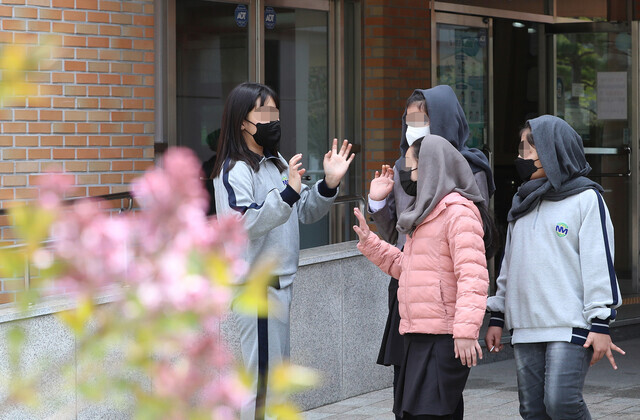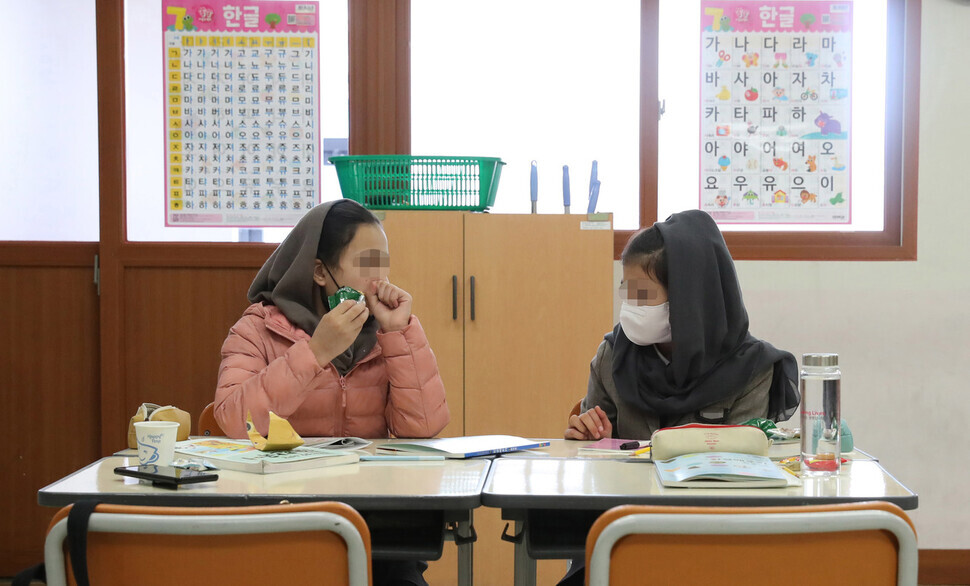hankyoreh
Links to other country sites 다른 나라 사이트 링크
Afghan evacuee children get by at S. Korean school with help of friends

Just after noon on Thursday, 13-year-old Tamana handed a paper penguin to her classmate A-ra, also aged 13, when A-ra stopped by Class No. 8 in their school. A-ra’s name was written in big block letters on the penguin, which Tamana had folded during class a few days ago.
Zarina and Aisha also took down their paper animals from the board and gave them to Seul-a and So-hui.
“You’re giving this to me? Thanks!” Seul-a said. Zarina produced a shy smile.
Tamana, Aisha and Zarina, all born in 2009, are the children of Afghans who were evacuated to South Korea in August 2021, after the Taliban, the extremist militant group, took over Afghanistan.
Following six months of education aimed at helping the Afghan evacuees become independent in Korea, 157 of them settled in Ulsan. Those families include 85 children and teenagers who began taking classes with their Korean peers at 17 of the city’s kindergartens, elementary schools, middle schools and high schools on March 21.
Images of those children heading to school for their first day of classes, carrying bundles of presents for their classmates, got a lot of attention. Aside from Seobu Elementary School, where 28 of the Afghan children are studying, each school is hosting two to four Afghan children.
On April 7, the Hankyoreh visited Nammok Middle School, in Ulsan, where Tamana, Aisha and Zarina had joined the first grade. The three Afghan girls were nonchalantly going about their school day, seemingly oblivious to the fact that there had been boisterous opposition to the idea of letting Afghan children attend Korean schools. The Ulsan Metropolitan Office of Education and the school staff are hard at work to help the children adapt to the school.
The Afghan girls spend most of their school time in Class No. 8, a special class designed to help students adapt to Korean culture. Tamana, Aisha and Zarina were originally assigned to three separate classes, but this year they will be learning the Korean language and Korean culture in this temporary ad hoc class.
But for six hours each week, they return to their original classes which they take alongside their Korean peers. A-ra, So-hui, and Seul-a are the Afghan girls' designated Korean “helper buddies.” All three volunteered for the role.
“At first, I was just curious why they’d come to Korea. But later, after I’d learned [about their situation], I wanted to get to know them and help out since they’d come from so far away,” So-hui said.
The three Korean helpers were wearing friendship bracelets that the Afghan girls had made.

The Ulsan Metropolitan Office of Education has assigned Korean language teachers from its multicultural support center and extra homeroom teachers to improve conditions for the Afghan students and help them make a smooth adjustment to life at school.
During second and third period on the day I visited, the Afghan girls sat in a circle and read phrases such as “draw a flower,” “eat rice,” and “wash hands” after Kim Min-jeong, their Korean language teacher, and then practiced writing the words on their own.
As the Afghan girls wrote neatly in their notebooks, one of them asked the teacher if her writing was correct. “I’m all done,” another said.
“While their Korean language ability is still at the kindergarten level, they have an intense desire to study. They’re really driven and ask me for extra learning material,” Kim said.
While the Afghan girls are learning about Korean, Korean grown-ups are also getting a chance to study, too.
“Before the Afghan students joined the school, the education office brought in outside lecturers on several occasions to help the teachers and administrators understand Islamic culture. In addition to the principal’s message during assemblies and creative, hands-on activities, teachers also talk to students [about Islamic culture] during their classes,” said Kim Mak-sun, the school’s vice principal.
The teachers at Nammok Middle School said the Afghan girls had been warmly welcomed by other students at the school.
“Things didn’t go as we’d feared they might. The kids here seem to be very friendly, perhaps because they’re in the first year of middle school. They say hi and even hug each other when they see each other in the hallway,” said Kim Ye-jin, the teacher in charge of managing the Afghan girls’ overall experience at the school.
Toward the end of lunch on the day I visited, a handful of Korean students in the hallway made a big heart with their arms through a classroom window toward the Afghan girls. A picture that the girls had taken with their Korean classmates was attached to the classroom board.
The school is still working on how to address the issue of cafeteria food. As Muslims, the Afghan girls can only eat halal meat, which comes from animals slaughtered according to Muslim precepts. But the lunch menu during my visit was rice mixed with barley, pork bone gamjatang stew, Andong jjimdak (braised chicken), stir-fried miyeok (seaweed) stems, Napa cabbage kimchi, and cheonhyehyang (an orange-mandarin hybrid).
While Zarina was fasting for Ramadan, the only dishes the other two girls could eat were the miyeok stir-fry, the mixed rice and the fruit, along with some fried eggs that the kitchen staff cooked up specially for them. So when Tamana got back from the cafeteria, she ate a separate lunchbox she’d brought in the classroom.
The school intends to set up a refrigerator and a microwave in case the Afghan girls keep packing their own lunches.
School principal Kim Man-seon said, “Children have the sensibilities of their country, wherever that may be. That’s true for Afghan children and for Korean children. Korea will gradually become a more multicultural society in the future. I hope that will be a society in which children can get along with each other.”
By Seo Hye-mi, staff reporter
Editor’s note: For the privacy of these young evacuees from Afghanistan and their classmates, this article uses pseudonyms in place of real names for students.
Please direct questions or comments to [english@hani.co.kr]

Editorial・opinion
![[Column] How opposing war became a far-right policy [Column] How opposing war became a far-right policy](https://flexible.img.hani.co.kr/flexible/normal/500/300/imgdb/original/2024/0702/5017199091002075.jpg) [Column] How opposing war became a far-right policy
[Column] How opposing war became a far-right policy![[Editorial] Korea needs to adjust diplomatic course in preparation for a Trump comeback [Editorial] Korea needs to adjust diplomatic course in preparation for a Trump comeback](https://flexible.img.hani.co.kr/flexible/normal/500/300/imgdb/original/2024/0702/9717199086060096.jpg) [Editorial] Korea needs to adjust diplomatic course in preparation for a Trump comeback
[Editorial] Korea needs to adjust diplomatic course in preparation for a Trump comeback- [Editorial] Silence won’t save Yoon
- [Column] The miscalculations that started the Korean War mustn’t be repeated
- [Correspondent’s column] China-Europe relations tested once more by EV war
- [Correspondent’s column] Who really created the new ‘axis of evil’?
- [Editorial] Exploiting foreign domestic workers won’t solve Korea’s birth rate problem
- [Column] Kim and Putin’s new world order
- [Editorial] Workplace hazards can be prevented — why weren’t they this time?
- [Editorial] Seoul failed to use diplomacy with Moscow — now it’s resorting to threats
Most viewed articles
- 110 days of torture: Korean mental patient’s restraints only removed after death
- 2[Editorial] Korea needs to adjust diplomatic course in preparation for a Trump comeback
- 3Nine dead in Seoul after car plows into pedestrians
- 4[Column] How opposing war became a far-right policy
- 5Japan is building a military meant for more than self-defense — and has the US to thank for it
- 6Samsung Electronics workers to go on first strike in company’s 55-year history
- 7Korea to create dedicated population strategy ministry to combat low birth rate, aging society
- 8S. Korea joins US, Japan for first multi-domain drills at a time of escalating tensions
- 9[Column] The miscalculations that started the Korean War mustn’t be repeated
- 10Nepotism remains prevalent at Korean chaebols